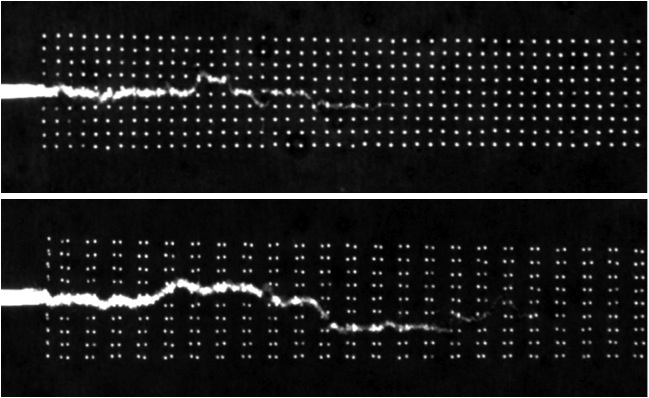More highlights |
Acoustics reveals the structure of granular systemsBecause of the complex way that internal networks arrange in a granular system, it is difficult to interpret the fingerprint left on an acoustic wave propagating through it. We developed a method using the ballistic part of the wave and we showed that the wave speed behaves as a power law of the applied compression force, and the power law parameters give informations on the geometry of contacts networks inside the pile. Revealing the structure of a granular medium through ballistic sound propagation, Lherminier et al., Phys. Rev. Lett. (2014). |
Different internal structures of the pile studied with the experiments. |
Aftershocks in subcritical fractureWe studied the subcritical propagation of one fracture in a sheet of paper. The fracture propagates intermittently, resulting in discrete acoustic bursts whose energy is distributed over a power law. We showed that, due to the existence of aftershocks, the power law’s exponent varies with the frequency of analysis of the acoustic signal. This result can be important for other experimental studies of phenomena presenting time correlations. Frequency monitoring reveals aftershocks in subcritical crack growth, Stojanova et al., Phys. Rev. Lett. (2014) |
a) Snapshot of the fracture. (b) Acoustic signal resulting from the fracture propagation. (c) Variation of the exponent of the events’ energy distribution for the raw experimental correlated data (red) and for an uncorrelated case (blue) |
Disorder and dynamics of fractureWe show that for the slow (subcritical) propagation of a single crack in a heterogeneous material, increasing the disorder results in an accelerated process. The observed effect is specific to slow fracture and result from applying a constant loading on a heterogeneous material, as such it is not easily identified with classical tests of materials. Our results are significant for the case of structures submitted to an essentially constant load, such as buildings, which are constantly evolving towards thinner and lighter designs. Effect of disorder on subcritical crack growth dynamics Ramos et al, Phys. Rev. Lett. (2013) |
 |
Instability in rupture of adhesiveWe show that the stick-slip instability observed when peeling an adhesive tape can be intermittent. Such intermittence is related to spontaneous fluctuations in peeling angles, that originates in low frequency oscillation of the roller angular velocity. The observed effect of peeling angle on the unstable regime is far from being well-known and questions the classical models linking peeling geometry to the fracture energy. Intermittent stick-slip dynamics during the peeling of an adhesive tape from a roller Cortet et al, Phys. Rev. E (2013) |
Experimental set-up of adhesive peeling. The peeling angle and angular velocity are measured using a fast camera (10 000 framesper second). |
Pressure solutionPressure solution is a mechanism by which minerals deform plastically in the presence of water. It contributes to the consolidation of active fault gouges following earthquakes and is responsible for the wet creep of plaster. We show that the force applied by an AFM tip impacts the velocity of atomic steps at the surface of a gypsum crystal experiencing dissolution under pressure. Those observations allow us to conclude that the phenomena is governed at the nanoscale by the same thermodynamic law that applies macroscopically. Pressure solution at the molecular scale Pachon-Rodriguez et al., Phys. Rev. Lett. (2011). |
Step velocity of atomic steps at the surface of a single gypsum crystal (left) experiencing dissolution in a flowing aqueous solution, as a function of the force applied by the AFM tip on the surface, for various saturation indices. |
|
|
|





















